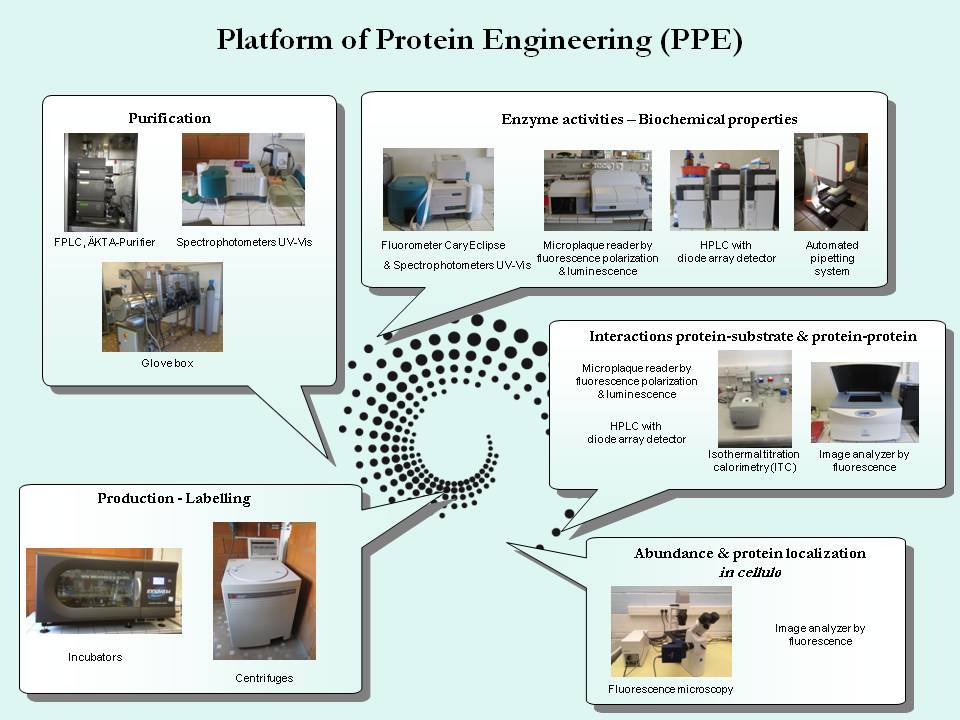Platform of Protein Engineering (PPE) – UMR INRAE-UL 1136 IAM
Manager: Tiphaine DHALLEINE
Protein engineering is to understand the relationship between the three-dimensional structure of proteins and their functions in order to determine their role in the living cell. Recombinant proteins can be produced and purified to investigate their physico-chemical properties, enzymatic mechanism as well as interactions with different ligands. The location of proteins in cellulo can also be studied at this platform.
Description of equipments:
Chromatographic systems FPLC (ÄKTA-Purifier, GE Healthcare) and HPLC (UFLC, Shimadzu)
FPLC (Fast Protein Liquid Chromatography) is a semi-automated liquid  chromatography technology. The ÄKTA Purifier-is equipped with piston pumps, a UV detector with variable wavelengths and a fraction collector. The columns now available are the analytical columns of size exclusion Superdex 75 10/300 and 10/300 Superdex 200 and the corresponding preparative columns 16/600 Superdex 75 and Superdex 200 16/600. Other columns for chelation on immobilized metal, HisTrap columns (1 and 5 ml), can also be connected on the ÄKTA Purifier. The equipment, placed in a refrigerated chamber at 4 °C, is controlled by the Unicorn 5.2 software (GE Healthcare).
chromatography technology. The ÄKTA Purifier-is equipped with piston pumps, a UV detector with variable wavelengths and a fraction collector. The columns now available are the analytical columns of size exclusion Superdex 75 10/300 and 10/300 Superdex 200 and the corresponding preparative columns 16/600 Superdex 75 and Superdex 200 16/600. Other columns for chelation on immobilized metal, HisTrap columns (1 and 5 ml), can also be connected on the ÄKTA Purifier. The equipment, placed in a refrigerated chamber at 4 °C, is controlled by the Unicorn 5.2 software (GE Healthcare).
HPLC (High Performance Liquid Chromatography) is a automated high pressure liquid chromatography. The UFLC system is equipped with piston pumps, an automatic sample injector, a fraction collector, a column oven and two detectors: a UV-visible detector with variable w avelengths and a diode array detector for the analysis of UV-visible spectra. The columns now available are the analytical reversed phase columns Gemini C18 5 µm 150 x 3 mm, Kinetex Biphenyl 5 µm 250 x 4.6 mm, Kinetex C18 2.6 µm 100 x 4.6 mm Jupiter C18 5 µm 250 x 4.6 mm and the corresponding preparative columns Gemini C18 5 µm 250 x 10 mm, Kinetex Biphenyl 5 µm 250 x 10 mm. A column of size exclusion BioSep SEC-S3000 300 x 7.8 mm can also be connected onto the HPLC. The UFLC system is controlled with the LC-LabSolutions software (Shimadzu).
avelengths and a diode array detector for the analysis of UV-visible spectra. The columns now available are the analytical reversed phase columns Gemini C18 5 µm 150 x 3 mm, Kinetex Biphenyl 5 µm 250 x 4.6 mm, Kinetex C18 2.6 µm 100 x 4.6 mm Jupiter C18 5 µm 250 x 4.6 mm and the corresponding preparative columns Gemini C18 5 µm 250 x 10 mm, Kinetex Biphenyl 5 µm 250 x 10 mm. A column of size exclusion BioSep SEC-S3000 300 x 7.8 mm can also be connected onto the HPLC. The UFLC system is controlled with the LC-LabSolutions software (Shimadzu).
Glove box (GP[Concept], Jacomex)
A glo ve box is a sealed container that is designed to allow one to manipulate objects where a separate atmosphere is desired (nitrogen atmosphere, in the absence of oxygen). Built into the sides of the glove box are gloves arranged in such a way that the user can place their hands into the gloves and perform tasks inside the box without breaking containment. Input-output airloks, of different capacities, allow exchanges with the outside.
ve box is a sealed container that is designed to allow one to manipulate objects where a separate atmosphere is desired (nitrogen atmosphere, in the absence of oxygen). Built into the sides of the glove box are gloves arranged in such a way that the user can place their hands into the gloves and perform tasks inside the box without breaking containment. Input-output airloks, of different capacities, allow exchanges with the outside.
Fluorescence system CaryEclipse (Varian) and microplate reader Victor X5 (Perkin Elmer)
The spectrofluorometer Ca ry Eclipse allows one to determine the concentration of fluorescent compounds and to follow-up enzyme kinetics within a range of 200 to 900 nm. This instrument is equipped with a xenon lamp. It is controlled with the software CaryEclipse ADL Shell Application (Varian).
ry Eclipse allows one to determine the concentration of fluorescent compounds and to follow-up enzyme kinetics within a range of 200 to 900 nm. This instrument is equipped with a xenon lamp. It is controlled with the software CaryEclipse ADL Shell Application (Varian).
The Victor X5 system is a microplate reader which detection is based on the emission and absorption of light, including luminescence, fluorescence, absorbance (visible and UV), time-resolved fluorescence and polarized fluorescence. A wheel carries different excitation and emission filters to select a wavelength of interest. The reader is controlled with the Perkin-Elmer 2030 software 4.00.
Image analyser Odyssey (Li-COR)
The Odyssey scanner is an imaging system in the infrared and near infrared for analyzing protein gels, DNA gels and Western blotting. The device is controlled with the 3.0 software Odyssey (LI-COR).
Isothermal titration calorimetry or ITC (MicroCal ITC200, GE Healthcare)
The isothermal titration calorimeter MicroCal iTC200 is a label-free syste m used to study a wide range of interactions between biomolecules. A direct measurement of the binding affinity, the stoichiometry and thermodynamic parameters of the interaction between two compounds, is performed in a single experiment. One of the two compounds is placed in a cell whose temperature is regulated while the other compound is taken with a motorized syringe and injected in several successive volumes in the stirred cell. Measuring the heat released (exothermic reaction) or taken up (endothermic reaction) upon interaction allows one to characterize the thermodynamic parameters of the interaction. The device is controlled with the MicroCal iTC200 software.
m used to study a wide range of interactions between biomolecules. A direct measurement of the binding affinity, the stoichiometry and thermodynamic parameters of the interaction between two compounds, is performed in a single experiment. One of the two compounds is placed in a cell whose temperature is regulated while the other compound is taken with a motorized syringe and injected in several successive volumes in the stirred cell. Measuring the heat released (exothermic reaction) or taken up (endothermic reaction) upon interaction allows one to characterize the thermodynamic parameters of the interaction. The device is controlled with the MicroCal iTC200 software.
Fluorescence microscopy (inverted micr oscope Axio Vert A1, ZEISS)
oscope Axio Vert A1, ZEISS)
The inverted microscope Axiovert A1 is an LED fluorescent microscope (transmitted light between 400 and 700 nm) for the observation of cells through different contrast methods that can be implemented. It is easy to switch between brightfield, darkfield, DIC, C-DIC, fluorescence and polarization contrast in reflected light. In transmitted light, brightfield, polarization and phase contrast are used. The device is equipped with a camera Jenoptik ProgGres and the system is controlled by the ProgRes CapturePro 2.8.8 software (Zeiss).
Terms and conditions of use of the equipments:
The platform PPE is open Monday to Friday by appointment with the manager. It is located within the UMR 1136 (1B entrance, floor 3) in the Faculty of Sciences and Technologies in Vandœuvre-lès-Nancy.
- Platform PPE manager:
Tiphaine D HALLEINE, Engineer, UMR INRA-UL 1136 IAM, Faculty of Sciences and Technologies, UL, 54500 Vandœuvre-lès-Nancy, Tel. 03 83 68 42 27, E-mail: tiphaine.dhalleine@univ-lorraine.fr
HALLEINE, Engineer, UMR INRA-UL 1136 IAM, Faculty of Sciences and Technologies, UL, 54500 Vandœuvre-lès-Nancy, Tel. 03 83 68 42 27, E-mail: tiphaine.dhalleine@univ-lorraine.fr
- Activities:
– Chromatography systems FPLC (ÄKTA-Purifier, GE Healthcare) and HPLC (UFLC, Shimadzu)
The FPLC technology is used to purify proteins either according to size by size exclusion chromatography (SEC) or according to the affinity of their His-Tag toward a resin of immobilized metal (nickel ions) affinity chromatography (IMAC), or according to the state of charge by ion exchange chromatography (IEC).
The HPLC technology is rather used to assay and purify small molecules such as extractable compounds from plants and enzymatic reaction products onto a reversed-phase column (RP-HPLC).
– Glove box (GP[Concept], Jacomex)
The glove box allows one to manipulate under nitrogen in an oxygen-free atmosphere in order to preserve certain proteins able to oxidize spontaneously in air (such as proteins containing an iron-sulfur center and some redox enzymes).
– Fluorescence system CaryEclipse (Varian) and microplate reader Victor X5 (Perkin Elmer)
These systems are used for fluorescent protein assays (labeled by a probe such as ANS, or conjugated to GFP or mCherry). They are also used for enzyme activity measurements. The Victor system, adapted for microplates, is suitable to the analysis of a large number of samples.
– Image analyzer Odyssey (Li-COR)
A number of applications of the Odyssey are possible. In addition to traditional Western blot visualizations on PVDF or nitrocellulose membranes, this device is used for the visualization and quantification of markers (single or double) directly in gel (In-Gel Western blot).
– Isothermal titration calorimetry ITC (MicroCal ITC200, GE Healthcare)
The MicroCal ITC200 system is used to determine the affinity parameters of the interaction between two compounds (protein-protein, metal ion-protein, protein-small molecule, …) such that the dissociation constant (Kd), the reaction stoichiometry (n) and the thermodynamic parameters of the reaction such that enthalpy (∆H), Gibbs free energy (∆G) and entropy (∆S). These parameters provide information about the chemical nature of the interaction (Van der Waals bonds, hydrogen bonds, hydrophobic bonds, and desolvation).
– Fluorescence microscopy (inverted microscope Axio Vert A1, ZEISS)
Fluorescence microscopy allows one to detect and locate a fluorescent protein in a living cell transformed or labeled in a plant extract and optionally to quantify this protein.
- Aims:
– To provide to the research partners the equipments available at the PPE platform and the methodological expertise necessary for project development.
– To contribute to the scientific reputation of the research unit by answering to the needs of scientific collaborators.
– To integrate user networks and develop interactions with other technology platforms to enrich the expertise and address the technical issues. To perform technology monitoring and forecasting of future investments.
- Specificities:
The platform PPE is integrated in the Redox team of UMR INRAE-UL 1136 IAM located at the Faculty of Sciences and Technologies of UL, in Vandœuvre-lès-Nancy.
The Research Unit IAM belongs to the scientific center A2F (Agronomy, Food & Forests), which includes six research laboratories in the federal institute EFABA (Forest Ecosystems, Agricultural Resources, Biomolecules and Food Industry). The A2F center relies on strong partnerships with INRAE and a partnership with AgroParisTech. The two major areas of the industry are (i) the forest and wood and (ii) agronomy and food industry. These axes belong to a competence center of the Ministry of Agriculture and Fisheries and the Ministry of Higher Education and Research, entitled FABELOR (Forest, Food Industry, Biotechnology, Environment in Lorraine). The Forest-Wood section is structured around the laboratory of excellence (LabEx) ARBRE.
The platform PPE will strongly interact with the future platform ASIA (Functional and Structural Approaches of Molecular Interactions in cells) supported by laboratories belonging to the A2F scientific center and located at the Faculty of Sciences and Technologies.


